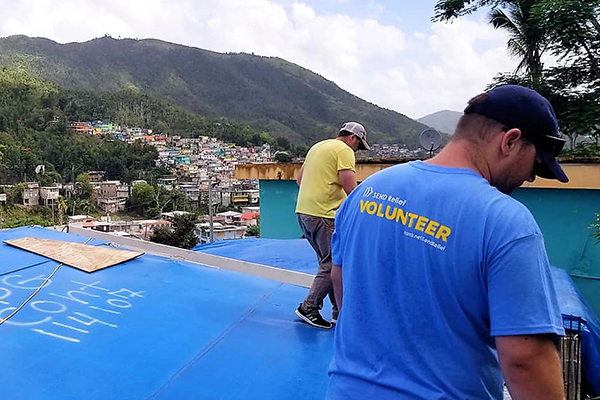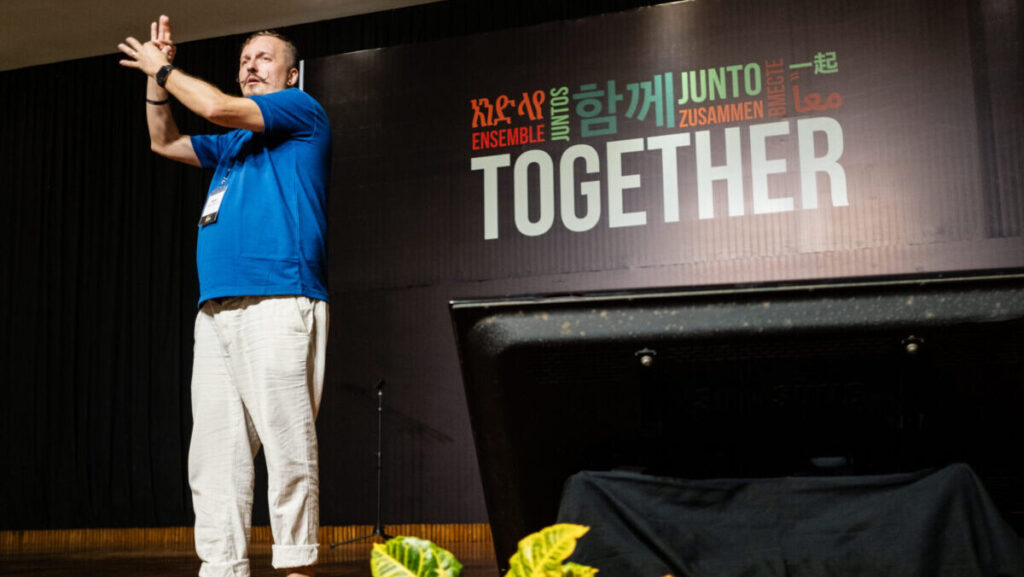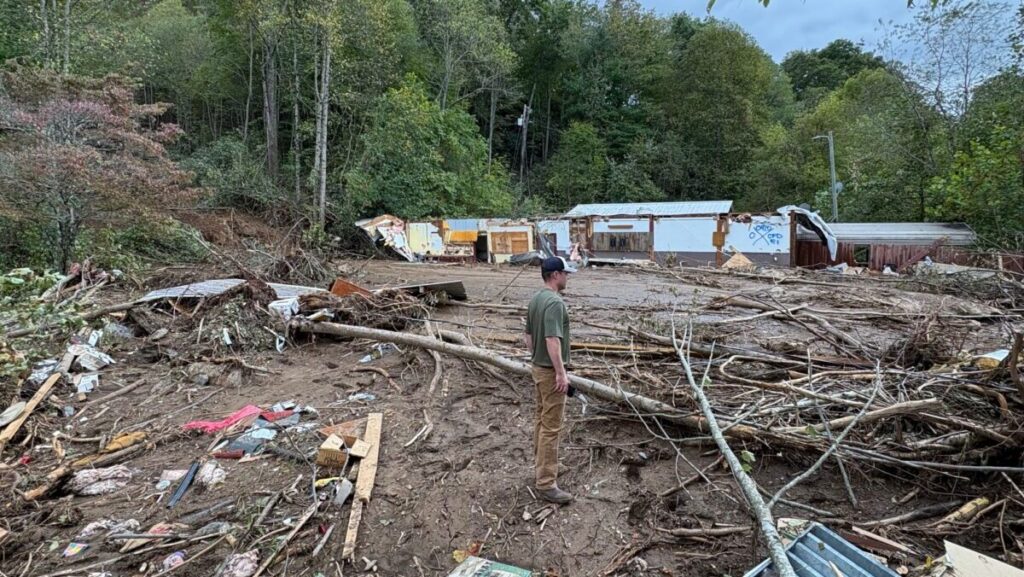For more than 50 years, Southern Baptists have been there. In the aftermath of hurricanes, tornadoes, earthquakes and other natural disasters, Southern Baptist Disaster Relief (SBDR) volunteers have been there to help individuals pick up the pieces of their forever-changed lives and rebuild on the spiritual foundation of Christ.
With its 70,000 trained volunteers and 1,550 mobile units for feeding, chainsawing, mudouts, child care and more, SBDR has become the nation’s third largest mobilizer of trained disaster relief volunteers, outpaced only by the American Red Cross and The Salvation Army.
Through the coordinated response of thousands of SBDR volunteers sporting their signature bright yellow T-shirts and caps, thousands of people have come to faith in Jesus Christ through the years.
Since the 1990s the North American Mission Board has helped coordinate the work of SBDR through state conventions. Today most of Southern Baptists’ 42 state conventions have their own disaster relief ministries. And countless associations assist the conventions by sponsoring teams and equipment focused on specific areas of work, such as chainsaw teams, laundry and shower units and feeding teams.
“Even when Southern Baptists were known for their infighting among themselves, Southern Baptist Disaster Relief was still viewed with respect and admiration across the nation,” wrote Lonnie Wilkey, editor of the Tennessee Baptist and Reflector, in a May 30, 2018, editorial.
However, with the launch of Send Relief by North American Mission Board (NAMB) in 2016, SBDR seems to be swirling in a storm all its own — a storm of confusion about the status of the historic relationship between NAMB and SBDR.
“The North American Mission Board developed and launched Send Relief to fulfill NAMB’s sixth ministry assignment from the Southern Baptist Convention (SBC) related to assisting churches as they serve disaster survivors and other people in need,” explained David Melber, president of Send Relief, which was set up as a nonprofit corporation but is governed by NAMB trustees.
Send Relief was established with five main priorities: poverty, refugees and internationals, foster care and adoption, human trafficking and disaster response.
“Send Relief is the compassion ministry arm of NAMB. We are to compassion ministry what Send Network is to NAMB’s church planting efforts,” Melber said.
Some associational and state leaders, fearing the nomenclature confusion between Send Relief and disaster relief might diminish traditional SBDR efforts, have questioned why SBDR was placed under the NAMB umbrella of Send Relief.
These leaders are concerned that SBDR funding as well as volunteer recruitment and training might be in jeopardy. Some even sense that Send Relief might be an effort to replace SBDR or compete with it.
Claiming that Send Relief “is capitalizing on the success of SBDR over the years,” Wilkey wrote, “I’m all for Send Relief as it deals with poverty, human trafficking, foster care and other important concerns, but it does not need a (disaster relief) element. We already have it.” He cited the experience of one individual who thought she was donating to SBDR for hurricane relief but was surprised when “the return information from NAMB was Send Relief stuff.”
Concerns
Tom Stacey, director of missions for Selma Baptist Association in Alabama, was more direct in his Send Relief assessment.
“The North American Mission Board through Send Relief is soliciting funds directly from Southern Baptist Convention churches to fund their SUVs (spontaneous untrained volunteers) that they will deploy to our area without notification of or in cooperation with the state convention or the association, so I’m asking churches to send their disaster relief funds to Selma Baptist Association,” he said.
“We raise our money to pay for our fuel, meals, motels, supplies, etc. We send our team all over, and NAMB doesn’t pay for any of that even though they are wanting people to give to them. … We have trained people on the ground doing the work, and we raise the money to pay for everything — the background checks, the equipment, everything,” Stacey said.
Melber has heard these objections to Send Relief, and he states there is no cause for alarm.
“The first thing to note is that Send Relief is pro-SBDR,” said Melber, who himself is trained in disaster relief “in multiple states.”
‘SBDR is invaluable’
“SBDR is invaluable and has made an immeasurable impact on communities both physically and spiritually,” he said. “Send Relief’s disaster response ministry aspires to build upon that legacy and encourages its volunteers to sign up with SBDR through their state convention.”
Through Send Relief, “We want to meet a physical need, to build relationships with people we are serving and ultimately to be able to share Christ,” he said.
In answering those who have asked if Send Relief is trying to replace SBDR, Melber responds, “An absolute no. We want to come alongside and support and, in a sense, kind of backfill where there could be some gaps,” such as in funding or in the volunteer base.
Send Relief “doesn’t do anything that would be what SBDR is known for, such as mass feeding efforts or credentialed chainsaw teams,” Melber said, but it does help resource those efforts.
In each of Send Relief’s priority areas, “Our efforts are designed to complement, not compete with these (state convention-sponsored) ministries,” Melber explained.
Send Relief’s nonprofit status enables the organization to solicit funds “outside of the traditional Southern Baptist fishing pond. … There are a lot of resources out there that I think we’re not going to necessarily ask for through traditional, historic Baptist practices,” Melber explained. He said he understands that state conventions solicit donations for SBDR through their churches.
“What we want to do is try to stay out of causing confusion with Southern Baptists (regarding disaster relief donations),” he said. Melber added that he recently counseled a minister at his home church in Alpharetta, Georgia, to send the church’s disaster relief donations to Georgia Baptist Mission Board Disaster Relief.
The bottom line for clarity is to determine where the person donating wants the funds to go, several officials involved in disaster relief efforts noted. Donating directly to an association will keep the funds related to that association’s disaster relief efforts. Donating to a state convention will keep the funds focused on that state convention’s disaster relief efforts. Donating to Send Relief will mean funds are used for a much broader purpose, but in all cases, marking the funds for “disaster relief” will ensure they are used for disaster relief efforts. Also, on the NAMB Send Relief website, users can link to several Baptist state conventions to make financial donations for SBDR.
Currently Send Relief is funded by contributions from NAMB, unrestricted gifts and designated gifts for specific areas, Melber said, with donations coming from individuals, grants, endowments and other sources.
As Send Relief seeks donations beyond traditional Southern Baptist means, Melber noted that last year Send Relief was included on the Obama Foundation website as third on the list of valid and trustworthy charitable organizations to which donors can send money. “How we got there (on the Obama Foundation website), I have no idea,” he said, but he saw major donations coming to Send Relief as a result.
Also, Send Relief welcomes volunteers who are not Southern Baptist, including individuals who are nonbelievers. “We believe including non-SBC and even unchurched volunteers is an effective way to share the gospel with nonbelievers as they serve alongside believers,” he said. With minimal training, these volunteers are put into action, usually for short-term opportunities, ranging from a few hours to a few days.
Send Relief does not respond to every natural disaster in the nation. Instead, it “primarily focuses on the largest regional and national events that draw significant interest from untrained volunteers,” Melber said.
Often “needs in a disaster outpace the ability to help,” Melber said, adding that Send Relief can sometimes get its less-trained volunteers on the ground immediately, “allowing time for SBDR to deploy. … There is a desperate need for more volunteers.”
Beyond disaster relief
With its five priorities, Send Relief also seeks ministry opportunities beyond disaster response. For example, in responding to hurricane devastation in Puerto Rico beginning in 2017 and continuing today, Send Relief leaders discovered the poverty level on the island is more than 50 percent. “We engaged in Puerto Rico because of the hurricane crisis. But when we engage with the people and figure out their more long-term needs, that leads us to consider how we address those needs because just getting a roof back on a house doesn’t solve the core issue.
“There are still tens of thousands of people without a roof in Puerto Rico, and it’s over a year later from the storm. We want to continue to replace the roofs, but if we don’t provide training and education for people to gain meaningful employment, then they will continue to deal with the effects of poverty which is cyclical and becomes a generational issue,” he said.
As natural disasters continue to pummel our nation, Melber said he doesn’t want Southern Baptists to be swept up in a storm of confusion within the denomination. “I hope and pray you’ve heard my heart in this,” he said, adding that his desire is that Southern Baptists will not have lingering questions or confusion about the relationship of Send Relief with SBDR.
To learn about Alabama Baptist Disaster Relief efforts or to donate, visit sbdr.org. To find out about Send Relief, visit sendrelief.org.






Share with others: